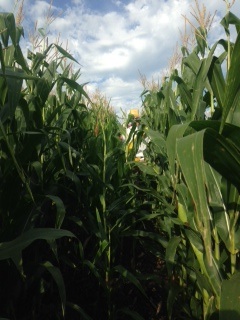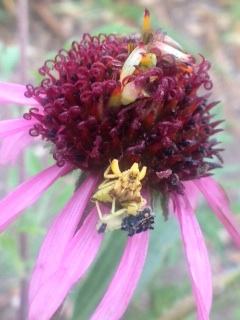|
|
On Tuesday we harvested 3 bags of heads from P1, 1 bag and 2 full egg cartons from P2

Today we trekked or “stalk whacked” through a corn field behind P1 to visit the site Kruzmarks

Where we found a sad looking Echinacea just peeking out from between blades of brome grass

where there was an interesting amalgamation of “ecosystems”… native prairie remnants, a pot hole, non-native conifer forest, and a monoculture of corn

Finally, we were able to finish out the day (Stuart’s last this season) at Staffenson. It was beautiful. White aster is blooming along with showy goldenrod and helianthus. Purple asters and gentians have maintained the purple hue as liatris is finishing blossoming.

Around the middle of peak flowering, a new character began appearing on Echinacea
heads. This is the ambush bug, the endearing name given to this insect, which looks like either a preying mantis or a miniature T-rex. As I do phenology I incidentally happen upon these bugs. Often times I will see an ambush bug on the same head over multiple phenology days. It appears that they prefer heads that are mid-flowering and they sit on the styles which are present below the row of anthers that are presenting pollen that day. I think that there may be a connection between a lack of shriveled styles and the presence of ambush bugs. Ambush bugs- members of the subfamily phymatinae- are predatory insects which lie in wait for other insects to land on the Echinacea head and then pounce. I enjoy taking advantage of this instinct by waving my pen in front of an ambush bug which will bat at the tip with their claw like front legs.
On August 2nd I found an ambush bug with prey in hand on a head at Steven’s Approach. You can see in the photo below that the ambush bug trapped a pollinator. The pollinator was still wiggling its leg bug the ambush bug maintained its grip.

This photo gives evidence of a potential mechanism for the hypothesized interference of style shriveling caused by ambush bugs. If the ambush bug pounces on a pollinator before said pollinator makes its rounds on a head, the styles will not receive compatible pollen and so will not shrivel. I think that the relationship of the ambush bug, pollinators and style shriveling would be a very interesting independent research project in the future.
Below is a photo of two mating ambush bugs. I first spotted this pair on August 8th on a head at East Riley. I was surprised to find that these bugs were in the same location two days later on August 10th. In this photo you can see the abundance of persistent flowers on this head. In addition, you can see that some of the florets are engorged and pushed up. This is most likely the result of a caterpillar or larvae predating on the flower or growing below the florets. Stay tuned to hear more about the saga of the ambush bug!


This week I was able to share my work with my parents and my brother. My parents came out in the field on Thursday to learn about how we document phenology in the remnants. My mother expressed her surprise that the remnants are much smaller than she had expected. Stuart was in the field with us and gave my parents a detailed explanation of what we are doing this summer and answered all of my parents’ questions. Yesterday my brother drove up to visit me. I showed him Staffenson prairie reserve which has blooming blazing star, sunflowers, lead plant, Echinacea, wild onion, bergamot and more! It was fun to show my older brother around and finally get a chance to teach him a think or two.
Today marked the first weekday of the peak week of flowering for Echinacea. We are working on phenology at all the remnants as will as P1. Several flowers are already on their last day of flowering. Despite the cold and blustery conditions of today the team did crosses for the compatibility project at Loeffler’s Corner and set up the project at East Elk Lake Road. Cam and I worked on my exhaustive crossing project at Yellow Orchid Hill. We weren’t able to collect pollen and cross until after lunch, but fortunately the pollen was not blown away by the wind! Tomorrow will be more phenology and compatibility!
This morning started with Jared and I doing an inventory of the Hesperostipa spartea (porcupine grass) in experimental plot 1. We are interested in determining the fitness of each H. spartea. We went to each plant found during a systematic search. We determined how many seeds were present on each culm of each plant. We counted the number of full (having a viable seed), inviable (having a seed that would not reproduce), or unknown (a glume that was empty, or peduncle that had no glume) seeds for each plant and harvested ripe seeds for later plantings. We found one studly plant that had 14 culms and 58 seeds that were ready to harvest! After experimenting with several methods of tying the immature awns together (to make sure we could find the seeds once they are mature and drop), we determined the most effective way to retain the seeds is to tie the awns together with twist ties. We hope the twist tie method allows us to harvest seeds before they disperse. We tried several other methods for tying the awns together (tying the awns to the stem, tying the awns to a red flag, and tying the awns together) but twist ties appear to work the best. In the afternoon I tagged my first Echinacea (plant 1980)!
These are the methods for the hawkweed removal experiment performed by Allison Grecco, Cam Shorb, Jared Beck and Elizabeth Mays in experimental plot 1. The percent basal cover of hawkweed in each quadrant is to be determined by Team Echinacea in Summer 2015.
Hawkweedremovalmethods.pdf
… to pull weeds, that is! Today Jared, Allie, Cam and I designed an experiment to determine the most effective and efficient way to terminate hawkweed from the SW corner of Experimental Plot 1 (P1). We created a 4m x 4m plot with 16, 1m quadrants. We originally wanted to have four treatments of: 1. Hand weeding 2. Hand weeding with tool 3. Painting round-up solution on peduncles after cutting off the flowering heads 4. Painting round-up on one leaf per basal rosette. Due to time restraints we had a fifth treatment: 5. No hawkweed removal (as a control). We learned a lot about experimental design while getting our hands dirty! In the afternoon we removed the rest of the hawkweed that was outside the plot and searched multiple rows in P1 for Stipa, affectionately known as “Porcupine Grass”. At least it’s not as smelly as the porcupines in the Colorado Springs Zoo! (Title of flog post inspiration courtesy of Rebecca Blacks infamous song “Friday”.)
I graduated this May from Colorado College with a B.A. in biology focused on Organisms, Evolution & Ecology and with a minor in Environmental Issues. In Colorado I learned about forest ecology, forest-fire ecology and short grass prairie ecology. I have also studied ecosystems abroad including the Mongolian Steppe and Altai Mountain range, the Ecuadorian mountain range, coastal range and tropical rain forest. Most recently I studied the Patagonian steppe in Argentina. I love traveling and learning about new ecosystems and cultures. I’m originally from the northern suburbs of Chicago where I grew to love prairies and Lake Michigan.
This summer I hope to study intrafloral seed set variation by observing stigma persistence and pollinator visitation frequency. I’m happy to be back working in the tall grass prairie!
You can learn more about my research interests by looking at my profile on the Echinacea Project website profile. https://echinaceaproject.org/people/2014-team-members/elizabeth-mays/

In a Lenga forest near Bariloche, Argentina
|
|









